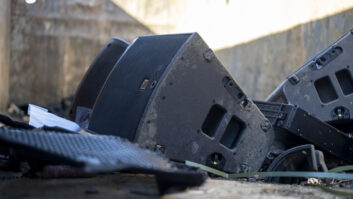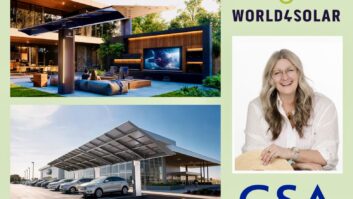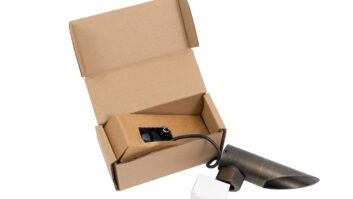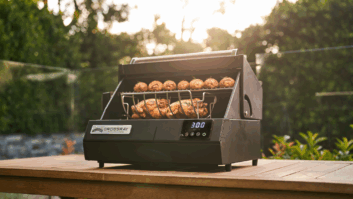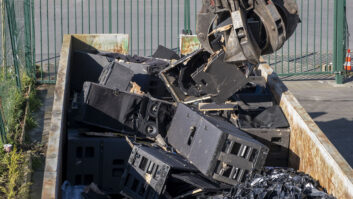NEW YORK – Whether positive or negative, big-box retailers have a major impact on the environment given the sheer size of their stores and the vastness of their chains and truck fleets.
Fortunately, most of the industry’s largest merchants have moved quickly to adopt best “green” practices for their stores, distribution centers and fleets, which saves them money, generates goodwill and helps limit environmental harm.
As leading CE and majap sellers, Best Buy, Walmart, The Home Depot and Abt Electronics have led the way as well in eco-innovations at the retail level.
Best Buy’s approach has been two-fold, focusing on the collection of used products for recycling or trade-in, and the replacement of those items with new, more energy-efficient models.
To help keep its categories out of the waste stream, the No. 1 CE chain accepts most used electronics for drop-off at its stores at no charge, regardless of where they were purchased, and will also provide free in-home pick-up when a replacement product is delivered.
With a Best Buy store within 15 minutes of 70 percent of the U.S. population, the company collects 400 pounds of CE products every minute and 170 million pounds of CE and majaps every year, which is significantly more than any of its competitors, the company said.
As it noted in a promotional video, “We make and sell the stuff, and not offering to recycle it would be like a bar without a bathroom – and that’s irresponsible.”
If the satisfaction of helping the environment isn’t enough to motivate consumers, the chain offers credit for product trade-ins, and was among the first in the industry to do so. Best Buy’s in-house program (games go to a third-party provider) accepts more than 11,000 different CE items, and this month, with the release of new flagship mobile phones, will offer multiple trade-in deals worth up to several hundred dollars in Best Buy gift cards.
The retailer was named 2014 Energy Star Partner of the Year by the U.S. Environmental Protection Agency (EPA).
Best Buy’s U.S. customers bought more than 20 million Energy Star-certified products last year, the retailer said, helping save more than $76 million in utility bills and keeping 1 billion pounds of CO2 out of the atmosphere — the equivalent of taking nearly 100,000 cars off the road.
At the Consumer Electronics Association’s CES On The Hill event Wednesday, April 30, Best Buy will be highlighting its electronics recycling program, its major appliance and TV haul-way offer, and its policy of mandatory e-waste certification by all CE recycling partners, among other efforts.
Meanwhile, Walmart’s green initiatives are even more ambitious as a worldwide retailer with an investment of in-house and third-party renewable energy programs and works to reduce its carbon footprint.
The former includes more than 180 renewable energy projects in operation or development around the world, which generate enough energy to power 78,000 American homes annually, the discounter said. The ultimate goal: to become fully powered by renewable energy.
To get there, Walmart is testing and scaling its own renewable energy projects like biodiesel generators, fuel cells, solar power and micro-wind at its stores and parking lots. These locally generated power sources have the potential to meet up to 60 percent of a store’s energy needs, the company said, pointing to its 26 fuel-cell installations in U.S. that are delivering 65 million kilowatt hours of electricity annually.
Walmart is also testing solar thermal, solar water heating and large-scale wind concepts in the U.S. and other global markets, while supporting third-party renewable energy developers through long-term green power purchase agreements (PPAs). These include five off-site utility wind projects, such as the 350 stores in Texas that receive up to 15 percent of their electricity needs from Duke Energy’s wind farm in Notrees, Texas.
To reduce its energy needs, Walmart is increasingly employing energy-efficient LED lighting on sales floors, in parking lots and in freezer cases within its stores and distribution centers, and said it was the he first retailer in the U.S. to incorporate a secondary loop refrigeration system for cold cases and walkin coolers to increase efficiency, prevent leakage and cut greenhouse gas emissions by as much as 95 percent.
The company is also putting industrial byproducts to good use: fly ash, a byproduct of coal-fired electrical generation, and slag, a byproduct of steel manufacturing, are used in the cement flooring mixtures of the chain’s new U.S. stores.
With one of the world’s largest truck fleets, Walmart also set a 10-year-goal to double fleet efficiency by 2015 through better route planning and space utilization, and by developing prototype trailers and tractors featuring light-weight carbon-fiber construction, natural gas engines and advanced aerodynamic designs.
But it is The Home Depot, which leads the home-improvement channel with 2,200 stores averaging 105,000 square feet in size, that can arguably make the biggest impact on the environment. Realizing that responsibility, the company is working to reduce its domestic energy usage and greenhouse gas emissions by 20 percent by 2015.
Reaching its five-year goal of cutting power consumption by 20 percent in its U.S. stores by 2015 will have saved about 8 billion kilowatt hours, or roughly enough energy to power over 800,000 U.S. homes for one year, the retailer said. To attain it, the company is re-lamping its stores with high-efficiency T5 fluorescent lighting, replacing old HVAC systems with new Energy Star-rated units, and is using LED lights for exit lighting, among other efforts.
To help reach its goal of reducing U.S. supply-chain greenhouse gas emissions by 20 percent by 2015 from 2008 levels, the company has, among other projects, piloted liquefied natural gas (LNG) truck trailers in Southern California; instituted a no-idling policy at all 65 U.S. distribution centers; and has reduced truck trips by 16 percent.
The Home Depot was also the first national retailer to accept CFL light bulbs and rechargeable batteries for recycling, and has helped conserve water by installing low-flow toilets and faucets and by building 81 water reclamation tanks between 2010 and 2012 for Garden Center irrigation that each save an average of 500,000 gallons per year, the company said.








